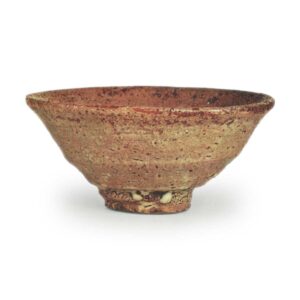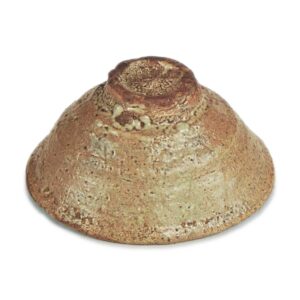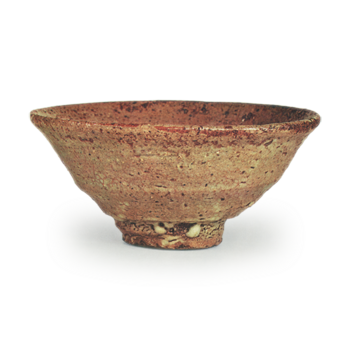

meibutsu
Height: 6.1-6.5cm
Diameter: 13.2-13.8cm
Outer diameter of foot ring: 4.5-4.7cm
Height of foot ring: 1.1-1.3cm
There are three famous bowls in Kanazawa called Aoido bowls. Namely, the Hōju-an, the Un’ei that has been passed down in the Fujita family, and this Yamanoi. The Hōju-an’s dignified appearance, the Un’ei’s elegant appearance, and the Yamanoi’s well-toned appearance all have their own unique appeal, and each of them is a famous bowl with a deep flavor, so it is no wonder that the tea masters of Kaga are proud of them.
By the way, Hōju-an and Un’ei were also listed in the Taishō Meiki Kan and were widely introduced, but this Yamanoi, along with Chōjirō’s Akaraku tea bowl Jirobō, was rarely seen in the world and was kept in the famous Murahiko family in the same area since the early Meiji period.
The name “Yamanoi” is written in gold powder on the inside lid, but the author is unknown. On the front of the inner box lid, in the style of Fumai, there is the inscription “Ido Aoyama no I”, but the calligrapher is Tanimatsuya Yashichi, also known as Toda Rogen, and according to the inscription on the back of the lid, it is said that he sought out the Rokujizo at the age of 24, and the Yamano I at the age of 65 in the third year of the Keio era. According to Rogen’s “Gogaku-shu”
According to the ‘Gogaku-shu’ by Rojin, he said, “I have sought out the Roku-jizo and the Yamanoi, but I have not seen a tea bowl that is as good as the Aoido.
In addition, regarding Yamanoi,
it is a small blue tea bowl with no faults, and is the best of its time. It was owned by the late Kajimura Hiko, and was previously owned by Isaka Rokuroemon. I am seeking it from the same person.
It is written.
According to this, it seems that Rogen valued the Yamanoi more highly than Rokujizo, and although Rokujizo was passed on to Fukuhisa Hyouzai of Kanazawa in the year following the year in which it was sought, it is thought that Yamanoi was held for a while. As Murahiko’s name already appears in the Gakushu-shu, it is thought that it entered the same family around the year 1887.
The name “Yama no I” on the small paper pasted to the inside of the lid is thought to be taken from the poem by Sōhō Sawao, “The water of Yama no I is good, but there is no one to draw it. was also used as the inscription on a tea caddy owned by the daimyo Fumai, but the small size and quiet appearance of this tea bowl probably convey the meaning of the song by Sōan, which expresses the boundary between the world of the tea bowl and the world of the top.
Indeed, Yama no I is a tea bowl with a deep and profound flavor that is second only to Hōju-an among the Aoido tea bowls. In particular, the shape of the side of the bowl is unusual for Aoido, with its varied curves, and the beauty of the way the potter’s wheel has been used to make it slightly deeper at the waist and then slightly more tapered towards the rim is particularly outstanding.
The thickness of the bowl is similar to that of Hōju-an, and it feels a little thick, but this is because the glaze is quite thick, and overall The glaze is strongly tinged with blue, and there are also areas with white glaze drips. The kaaragi (a type of pattern) from the foot ring to the inside of the foot ring is finely and roughly textured, and the glaze from the outside to the foot ring is particularly outstanding, as with Hōju-an.
The interior is different from the exterior, with a quiet and subdued atmosphere, and there are four eye marks on the inside. Furthermore, it is also rare for a well to be free of flaws, and this is thought to be something that Rogen highly valued.



